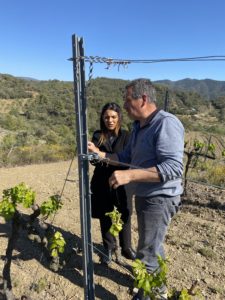
Continued drought threatens 2023 vintage across Spain
With vineyards only just budding across Spain, it may seem early to start talking about the 2023 harvest, but given the low rainfall over the winter and spring period, concern is already rising about how drought could affect this year’s grape production.
William has been travelling across Spain this week, visiting vineyards in Penedès, Priorat, Montsant, Rioja, Rueda and Guadalajara. These included the winery that makes Clos del Bou in DO Priorat, where owner Josep Gomez spoke of the challenges that the on-going lack of rain presents:
“Last year was a particularly dry in terms of rainfall and coupled with the extreme temperatures, production was down 35% on average. This year looks to continue in the same vein, unless we get some rain in May.”
Unfortunately, this does not look likely as AEMET, the Spanish government meteorological agency, predicts: “We are not forecasting much rainfall in May and June is never usually wet,” explains AEMET spokesperson Rubén Del Campo. “We are expecting another hot summer. We don’t know if it will be as hot as last year but certainly well above average.”
The Spanish Ministry for Agriculture is hosting a National Drought roundtable next week to discuss the issue as very little rain has fallen this spring (less than 2 litres per square metre on average across Spain) and during the period since the 1st October only 334 litres per square metre fell, 19% less than average.
Northern areas and Andalucía are the areas that have been most affected with much less rainfall than normal. This includes northeast Castilla y León, the Basque Country, Navarra, Northern Aragón, Cataluña, Andalucía and southern parts of Castilla-La Mancha.

Parched vineyards in Spain
The approximately 40% of Spanish vines that are irrigated, a figure that has doubled in the past twenty years, may seem to be under less danger, but water supply is always an issue and the threat that the regional government will limit agricultural water supply looms large. This is the case for the winery that produces Finca Mónica from irrigated vines in the Rioja Oriental. With so little rainfall, groundwater levels are much lower than usual and the percentage of water in reservoirs is at its lowest level since 2011 after 2022, with reservoirs in Murcia at just 28% of capacity.
Murcia is the region where we find the DO Jumilla. Old vine Monastrell is generally well adapted to the arid conditions that are habitual here. But the soil makes a big difference, at Viña Elena in Jumilla we saw virtually adjacent vineyards of a similar age that have suffered very different fates. The one on land that prevents deep root growth has had to be grubbed up and the other – on calcareous stony soil with broken down subsoil – the roots can reach down deep to get the moisture they need and are so far doing just fine.

Josep Gómez in his Priorat vineyard
Back in Priorat, Josep explains the work he has been doing to improve the quality of soils to try to help his organically-managed, dry-farmed vines, a true labour of love:
“In the face of such conditions, we can’t just stand here with our arms folded, we have to try to help the vines. What we’ve been doing in our organic vineyards is to treat a section of the soil every year to try to help it retain water and nutrients. We mix sheep’s manure with leonardite – an organic material associated with lignite that has not yet completed the process of transformation to coal – and apply that to the soil. We’ve also been experimenting with the use of diatomaceous earth. This also helps retain moisture and has the additional benefit of also controlling the larvae of the grapevine moth when applied at the right moment. We spray the vine with this in powder form, which gives them a white coating that helps reflect the sunlight. This year, we’ve also been removing some of the shoots to balance growth and ensure the vine doesn’t over stretch itself in terms of production.”
As for the grapes grown in the area, he explains that Cariñena and Garnacha are best adapted to drought conditions, with Cariñena giving particularly good results in the area at 500-700 metres altitude, adding acidity and structure to the blend.
Fingers crossed for some welcome rain to help alleviate the drought.





